A prominent feature of animals is the tail; some tails are longer than others.
These long tails play significant roles to the animals and are not there simply for beauty, though beauty can be an essential factor, as is the case of the peacock. Some animals with long tails use it to protect themselves, others for balance, etc.
One thing is for sure, the long tails form a significant part of these animals’ physical buildup, and they would be at a substantial loss without them.
This article presents 30 of the animals with the longest tails out there. Before that, we’ll look into what makes a tail and the many functions it serves.
Animal Tail Overview
The tail is the extended part of the rear end of many animals. They can appear in different ways, ranging from long to short and slim to fluffy.
Vertebrates usually have tails, but it isn’t limited to them alone. Invertebrates like scorpions, slugs, and springtails have appendages that can be called tails too.
The tail consists of caudal vertebrae, muscles, and some tissues. The tail length determines just how many caudal vertebrae there are in a particular animal.
Vertebrae, in general, are a series of bones that make up the backbone, and there are 5 of them: the cervical, thoracic, lumbar, sacral, and caudal.
The caudal makes up the tail.
What is the Function of the Animal Tail?
The tail is an asset to many animals and has numerous functions like balancing, protection, communication, and grasping.
Balance
For many animals, tails help them maintain balance, especially for those with small bodies or aquatic animals with fins.
Balance is also tied to movement; the tail helps animals remain balanced as they navigate their terrain.
Protection
Protection is both offensive and defensive, and some animals use their tails for both. An example is a stingray with barbs at the end of the tail to ward off predators.
Communication
One often understated function of the tail is that of communication. Animals can use their tails to communicate, either as a warning or to find themselves.
In terms of communication, tails also serve to declare mating intentions and attract potential partners.
Grasping
Animals that live more on trees—like monkeys—use their tail as a third hand.
These tails are called prehensile tails and are used to grasp objects. Thus, grasping is another function of the tail.
Examples of Animals With Long Tails
1. Alligators
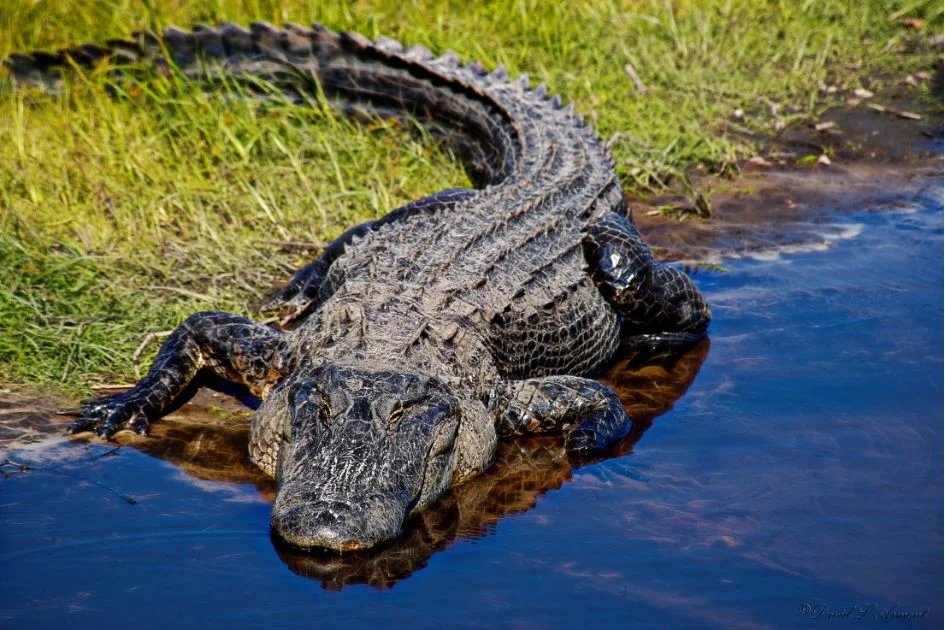
- Scientific Name: Alligator mississippiensis
- Tail Length: 7 to 7.5 feet
- Where Found: United States, Mexico, China
The alligator is a reptile that lives in water but not underneath it like a shark and other fishes.
It stays on the surface of water bodies, and while it is often mistaken for its close lookalike, the crocodile, the alligator is a different reptile.
There are two extant species of the alligator: the American alligator and the Chinese alligator.
Alligators use their tails mainly to swim and swish the tails to move or propel themselves forward.
The tail also serves as a weapon to ward off a predator or stun prey.
2. Angola Colobus
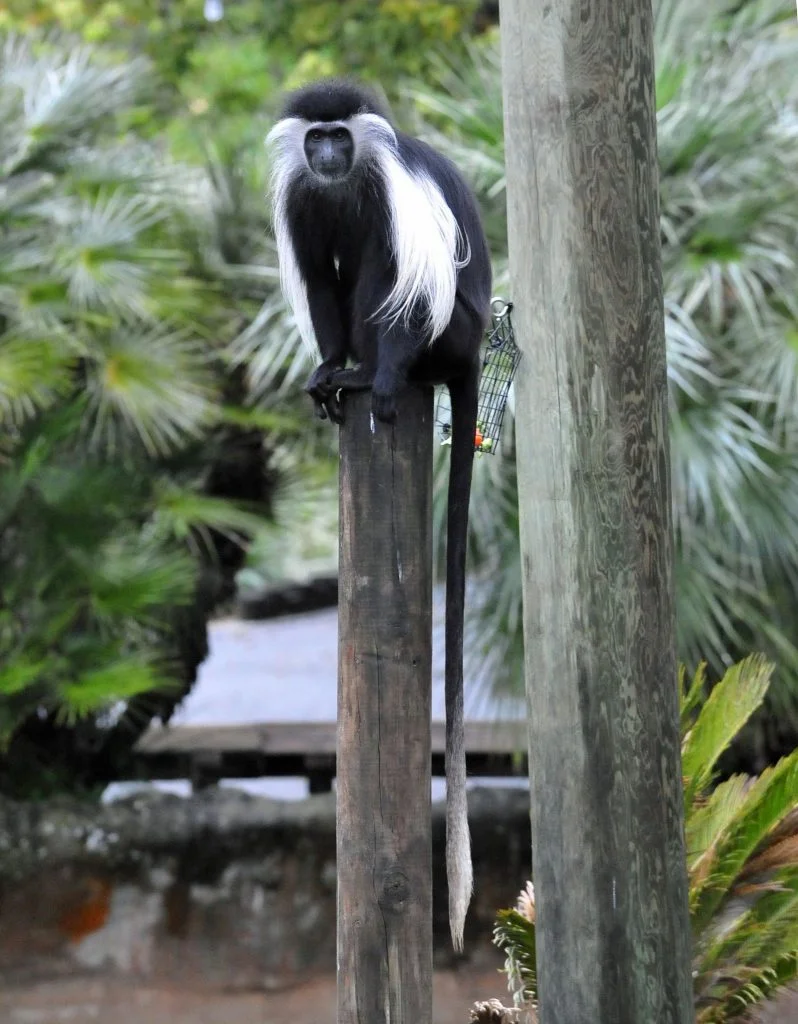
- Scientific Name: Colobus angolensis
- Tail Length: 75cm
- Where Found: Congo Basin
The Angola Colobus is a monkey with a tail longer than that of the alligator. It lives in the Congo Basin and can be found in dense rainforests.
It is also known as the Angolan black-and-white Colobus and the Angolan Colobus.
A sociable animal, you’d hardly see an Angola Colobus moving solo.
The 75cm tail plays the role of balance as the Colobus goes from tree to tree. It also uses its tail to grasp the tree while eating or trying to escape from predators.
3. Ring-tailed Lemur

- Scientific Name: Lemur Catta
- Tail Length: 61cm
- Where Found: Madagascar
The ring-tailed Lemur’s tail length stands out, thanks to the color patterns, and it is long, reaching 61cm.
The Lemur looks like a raccoon because of its looks and the black and white color pattern.
Lemurs stay on forest canopies but can be found on the ground. They are omnivores, and their diet includes insects, bark, and flowers.
This animal uses its tail for balance, and though it is not prehensile, it helps them climb trees.
To the Lemur, the tail is also a form of communication with other Lemurs in the group, known as troop mates.
4. Black Spider Monkey
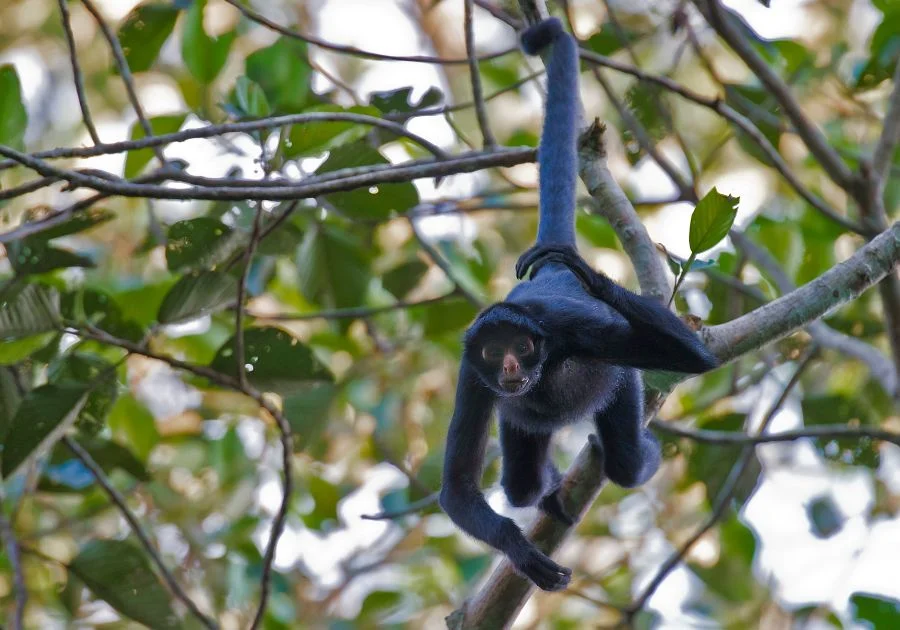
- Scientific Name: Ateles paniscus
- Tail Length: 28 to 34 inches
- Where Found: South America
The Black Spider Monkey is a good example of a prehensile tail; its main function is to help the monkey climb trees and travels through trees.
The tail’s length can get up to 81cm, even longer than that of the Angola Colobus. The Black Spider Monkey lives in Central and Eastern South America.
Its habitats are tropical and subtropical rainforests.
As the name implies, the Black Spider Monkey is usually black, except for the face, which is colored red in adults.
Younger ones start with a black face which slowly transitions to red. The stereotype of monkeys eating fruit is true for the Black Spider Monkey.
5. Green Iguana
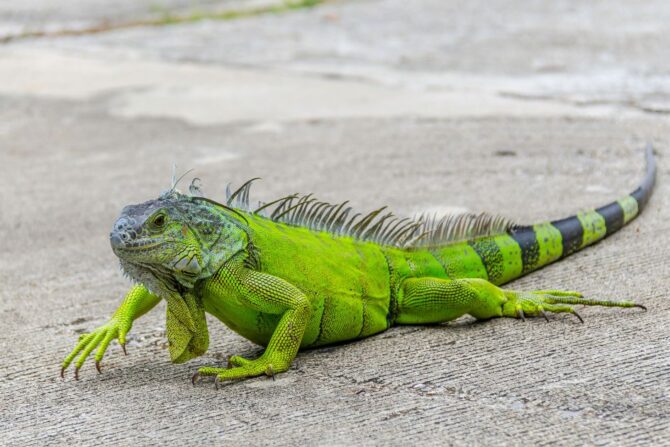
- Scientific Name: Iguana Iguana
- Tail Length: 1m
- Where Found: South America
Also known as the Iguana Iguana, American Iguana, or Common Green Iguana, this animal is one reptile that’s kept as a pet, though not by everyone.
Taking care of a Green Iguana takes a lot of commitment, but regardless, it is among the most popular exotic pets.
This reptile originated in Central and South America before getting into the United States.
The Green Iguana has a body length of 2m, and the tail makes up half of it. It uses the tail to move and protect itself.
The second role is interesting here—when the Green Iguana faces a predator, it can go either fight or flight, and the tail helps with both situations.
When it wants to fight, it strikes with the tail. It can leave its tail behind when it prefers to run away and grow another.
6. Sakishima Grass Lizard

- Scientific Name: Takydromus dorsalis
- Tail Length: 9 to 10 inches
- Where Found: Japan
The Sakishima Grass Lizard is a native of Japan and is currently listed as an endangered species.
It is often colored lime green. Not surprisingly, it lives in grasslands where it can camouflage.
The Sakishima Grass Lizard has a long body with a tail that’s even more so.
No one knows what the Sakishima Grass Lizard uses its tail for because of its rarity.
That said, we can guess that the Sakishima Grass Lizard uses the tail to navigate, similar to other reptiles. It might also serve as protection.
7. Eastern Glass Lizard
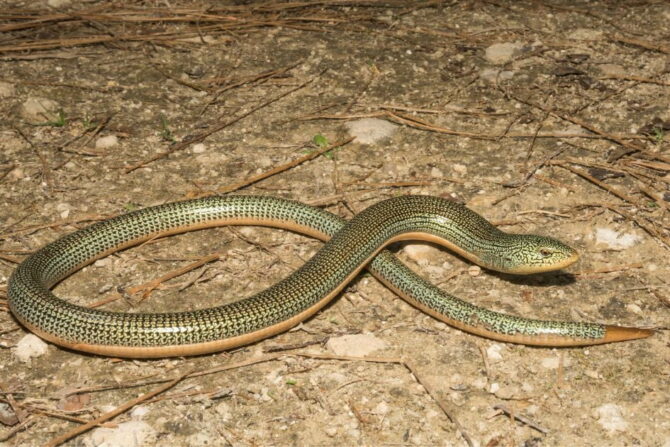
- Scientific Name: Ophisarus ventralis
- Tail Length: 42.6 inches
- Where Found: Georgia, North Carolina
One glance at the Eastern Glass Lizard, and you would think it is a snake because it has no legs. However, it isn’t a snake specie but a unique-looking lizard.
The Eastern Glass Lizard is a native of the United States, specifically in the southeastern regions where they are found in wetlands.
Besides using it to navigate as it crawls on its battery, the Eastern Glass Lizard can also detach its tail while escaping from a predator and grow it back, proving helpful in protecting itself.
8. Binturong
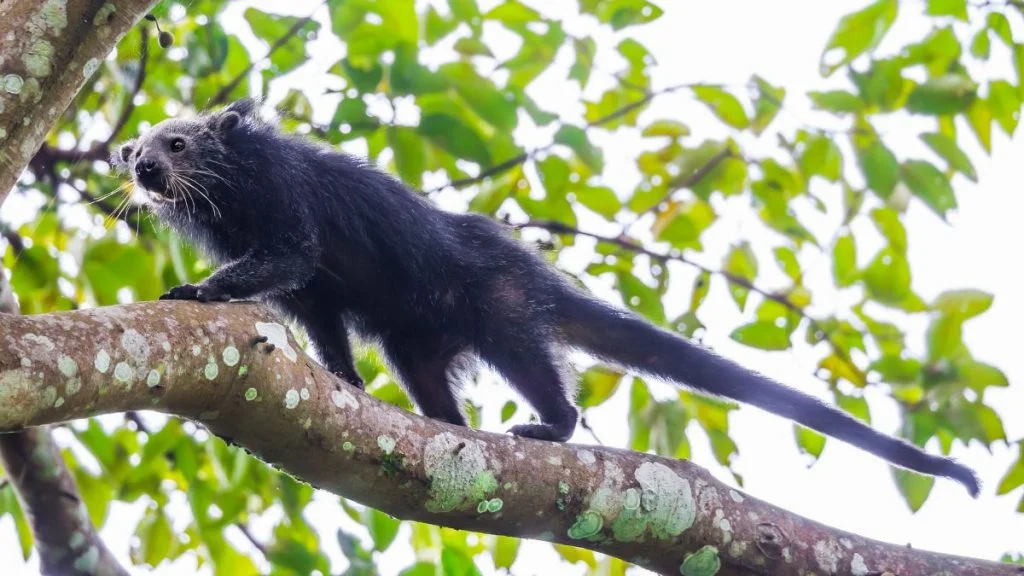
- Scientific Name: Arctictis binturong
- Tail Length: 28 to 33 inches
- Where Found: Southeast Asia
The Binturong is often found in dense forests and is a native of Southeast Asia. It looks a little like a bear, which earned it the name Bearcat.
You’d recognize this specie by its black fur and white stripes. It has been classified as vulnerable, just a step away from being endangered.
Its tail is half of its body and plays a significant role in balance when climbing trees. The Binturong eats berries, birds, eggs, and small animals.
9. Black Wildebeest
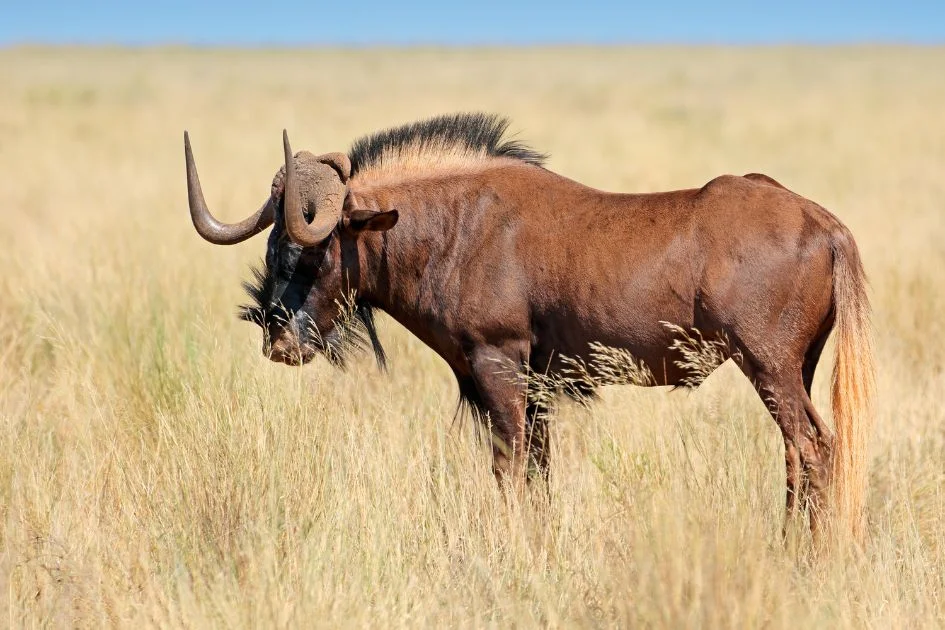
- Scientific Name: Connochaetes gnou
- Tail Length: 100cm
- Where Found: South Africa
Weighing over 300 pounds, the Black Wildebeest is the largest of its kind. It comes from South Africa, where it stays in open plains, Karoo shrublands, and grasslands.
The Black Wildebeest can also find it in Eswatini, Lesotho, and Namibia. It is a herbivore and prefers grazing on small grass.
The Black Wildebeest’s tail gets up to 100cm, and it uses the tail to keep balance while it runs and to regulate body temperature.
The tail also chases away intrusive insects. This mammal almost got extinct in the 19th century but survived and is now considered least concern.
10. Common Thresher Shark

- Scientific Name: Alopias Vulpinus
- Where Found: Northwest Atlantic Ocean
- Tail Length: 3 meters
The Common Thresher Shark is considered the largest thresher shark species, and its long fin takes up most of its body.
The fin is up to 3 meters and is considered long for a fish.
The Thresher Shark can be found in the Northwest Atlantic Ocean, where it keeps itself alive by targeting small fishes like herrings and anchovies as prey.
This shark also knows how to swim with speed. The tail first serves as a hunting tool, which the Common Thresher Shark uses like a whip to stun its prey so it can’t escape.
This Shark species often terrorizes schools of small fish.
11. Crocodiles

- Scientific Name: Crocodilydae
- Tail Length: 7 to 7.5 feet
- Where Found: Africa, America, Australia, Asia
The crocodile is the popular twin reptile of the alligator, and it can be found in the tropical habitats of Africa, Australia, Asia, and the Americas.
The crocodile looks like a crawling, armed reptile, and it shouldn’t come as a surprise that it is carnivorous.
Its 7 feet tail is an essential hunting weapon, and it uses that to its advantage.
Besides using it to propel itself through water, the crocodile uses the tail to attack prey and to keep its balance when moving on land.
The crocodile’s jaw is long and strong; you do not want to find your feet caught between it.
12. Giraffe
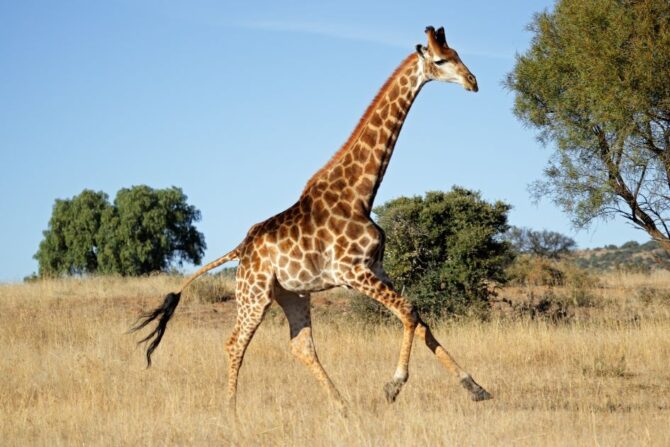
- Scientific Name: Giraffa
- Tail Length: 3.3 feet
- Where Found: Africa
An easily recognized animal, the giraffe is popular for its long neck. It can be found in the semi-arid savannah and the woodlands of Africa and is considered the tallest animal in the world.
The giraffe is a herbivore, and its long neck helps it get to branches on trees.
The tail measures up to 3.3 feet, and its primary purpose is to help the giraffe maintain its balance while running.
The giraffe is classified as vulnerable, and the remaining are kept in national parks, reserves, and zoos.
13. Indian Giant Squirrel
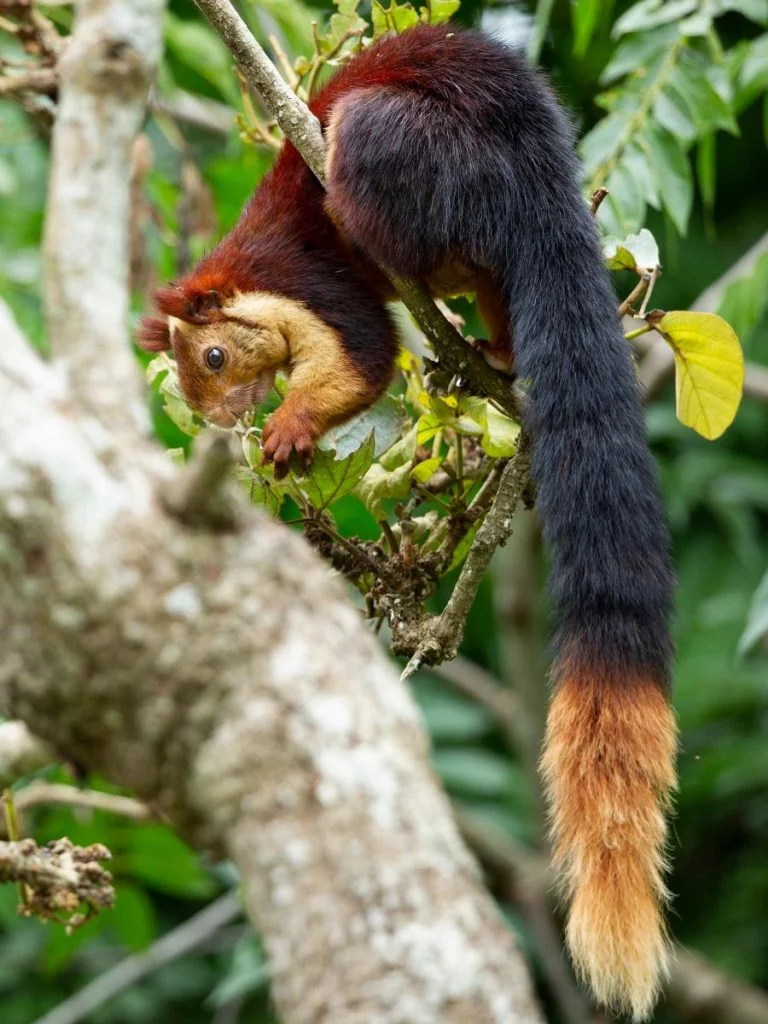
- Scientific Name: Ratufa Indica
- Tail Length: 45cm
- Where Found: India
Also known as the Malabar Giant Squirrel, the Indian Giant Squirrel is the first long-tailed rodent on our list of animals with long tails and the largest tree squirrel in the world.
It is found only in India and has a tail that makes up most of its body length. Some habitats the Malabar Giant Squirrel lives in include forests and woodlands.
The tail serves to provide balance as it scurries on trees.
This species has four recognized subspecies: R.i indica, R.i. centralis, R.i. dealbata, and R.i. maxima.
14. Reticulate Whipray

- Scientific Name: Himantura uarnak
- Tail Length: 14 feet
- Where Found: Indian Ocean, Pacific Ocean
The Reticulate Whipray has a distinctive shape. Its upper part is in the form of a circle with a skinny tail sticking behind it.
The tail has barbs that can be used as a weapon and are three times longer than the body. They live underwater, in the seas of the Indo-Pacific and French Polynesia.
As a weapon, the Reticulate Whipray keeps away predators with sharp barbs. The tail also helps it navigate the underwaters.
15. Indian Peafowl

- Scientific Name: Pavo cristatus
- Tail Length: 5 feet
- Where Found: Sri Lanka
Also called a peacock, the Indian Peafowl has one of the most beautiful tails and is made up of colorful feathers. The tail feathers are called a train and can get up to 5 feet.
Do note that while this bird species has been nicknamed a peacock, in actuality, only the male is a peacock; the female is called a peahen.
The Peafowl originated from India and Sri Lanka but can be found in other parts of the world, including the United States.
This bird is an omnivore, feeding on insects and plants. The peacock (the male) uses his tail feathers as a form of attraction to draw in the female.
16. Long-tailed Widowbird
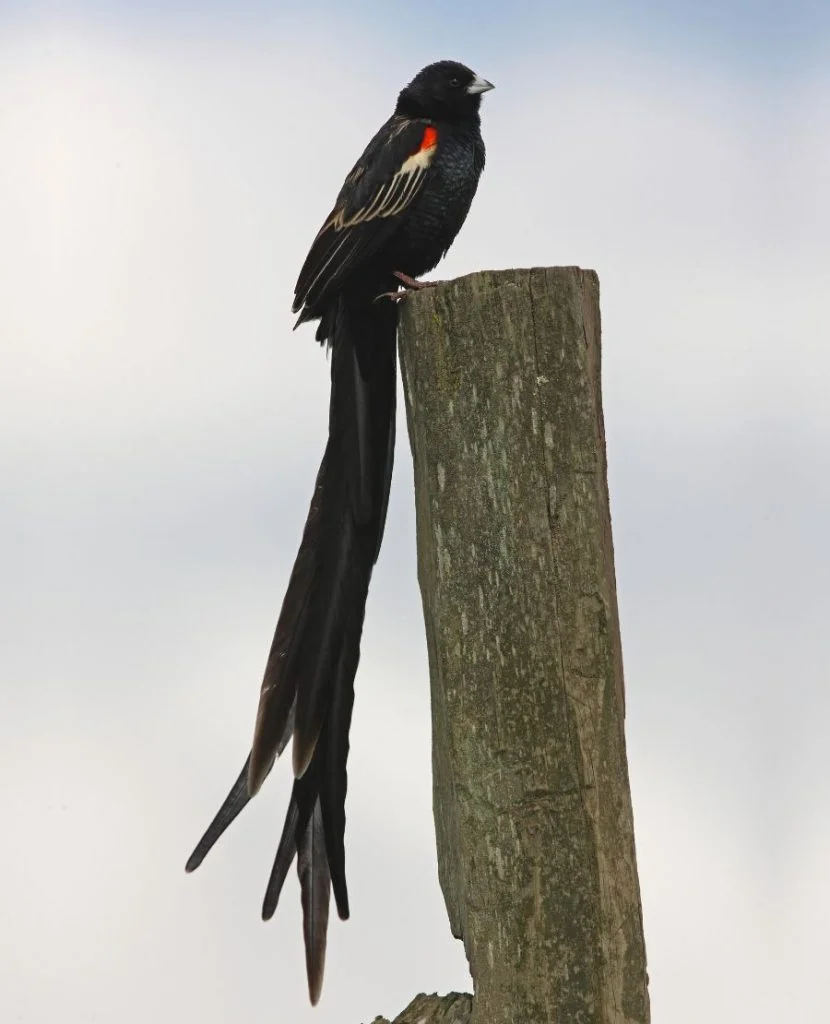
- Scientific Name: Euplectes progne
- Tail Length: 20 inches
- Where Found: Africa
The Long-tailed Widowbirds have long tail feathers, and on that note, it is similar to the Peafowl.
However, its tail is not as colorful. It lives in the southern region of Africa, specifically in marshes, swamps, and grasslands.
The Long-tailed Widowbird uses its tail much the same way as the Peafowl. The male opens it to attract the female.
It is also displayed when they fly, suggesting that it helps them glide through the air.
17. Northern Tree Shrew
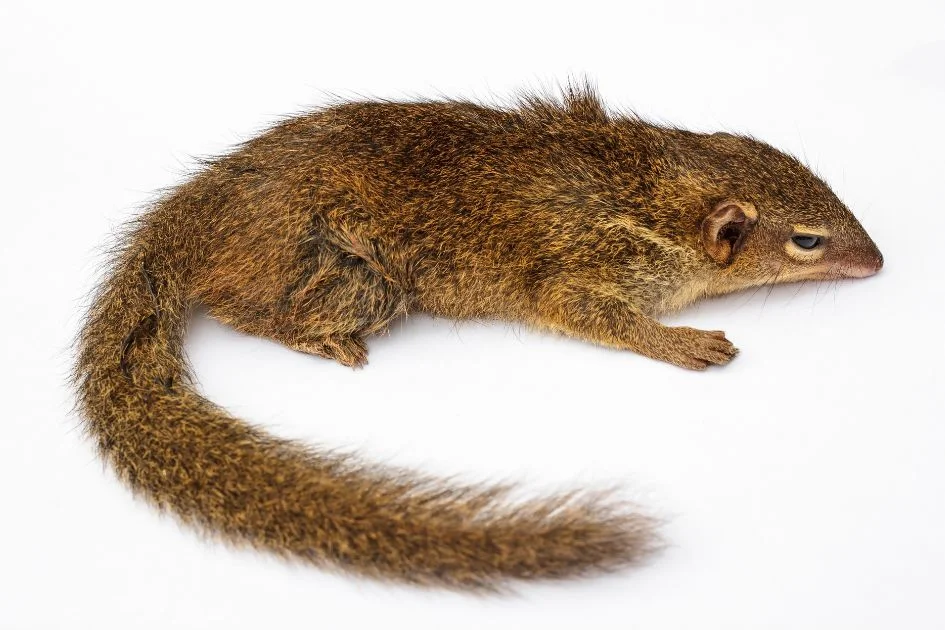
- Scientific Name: Tupaia belangeri
- Tail Length: 9 to 10 inches
- Where Found: Southeast Asia
The Northern Tree Shrew has a close semblance to the squirrel but is a different animal.
It lives in the rainforests of Southeast Asia, and just as the name implies, it stays on trees.
It can also be found on the grounds, though. It sports a gray and olive green fur, with a long snout and bushy tail.
The tail is just as long as its body and uses it for balance and communication.
The Tree Shrew’s diet is the nectar of plants, and they give back nutrients to the plants in form of feces. That’s a symbiotic relationship at its best.
18. Banner-tailed Kangaroo Rat
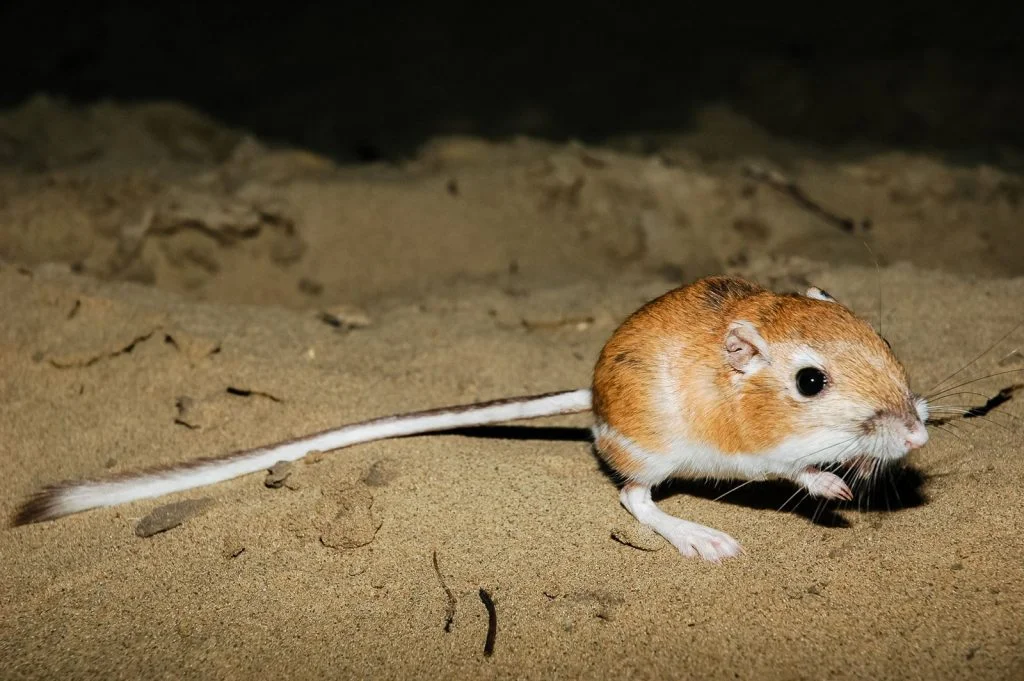
- Scientific Name: Dipodomys spectabilis
- Tail Length: 16.5cm
- Where Found: United States
The Banner-tailed Kangaroo Rat is a native of the United States and has made a home out of deserts and grasslands.
As a rodent, it often stays in burrows, where it spends most of its short lifespan. The Banner-tailed Kangaroo Rat has a life expectancy that falls between 2 to 5 years.
The “Kangaroo” in its name is because of the pouch on its cheeks, where it carries seeds back to the burrow.
The tail length gets to 16.5 cm, which is slightly longer than the body length (9 to 14 cm).
It uses the tail to keep balance, especially when jumping away from predators. This rodent is also good at camouflage because of its color.
19. Howler Monkey
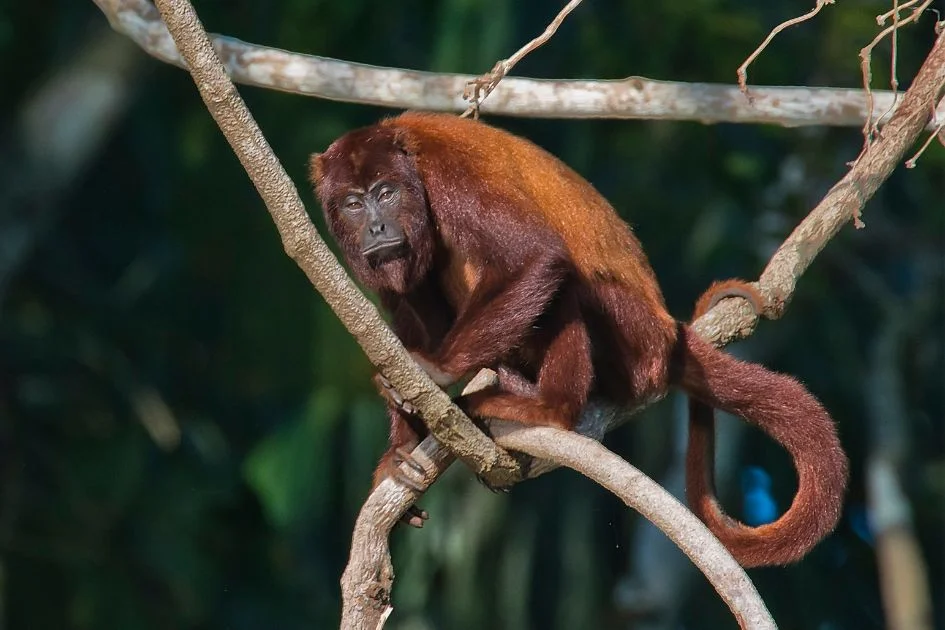
- Scientific Name: Alouatta
- Tail Length: 20 to 30 inches
- Where Found: Southern America
Yes, the Howler Monkey howls, and it is considered one of the loudest mammals out there.
It is a native of South America and is usually found in rainforests. The Howler Monkey’s howl can be heard miles away.
While it is endangered, it is often threatened by hunters, the destruction of habitat, and those who capture it for the zoo.
Howling is this animal’s most definitive trait, but not the only one.
The Howler Monkey has a long tail, reaching 75cm in length. The tail helps it navigate through its environment.
20. Ribbon-Tailed Astrapia
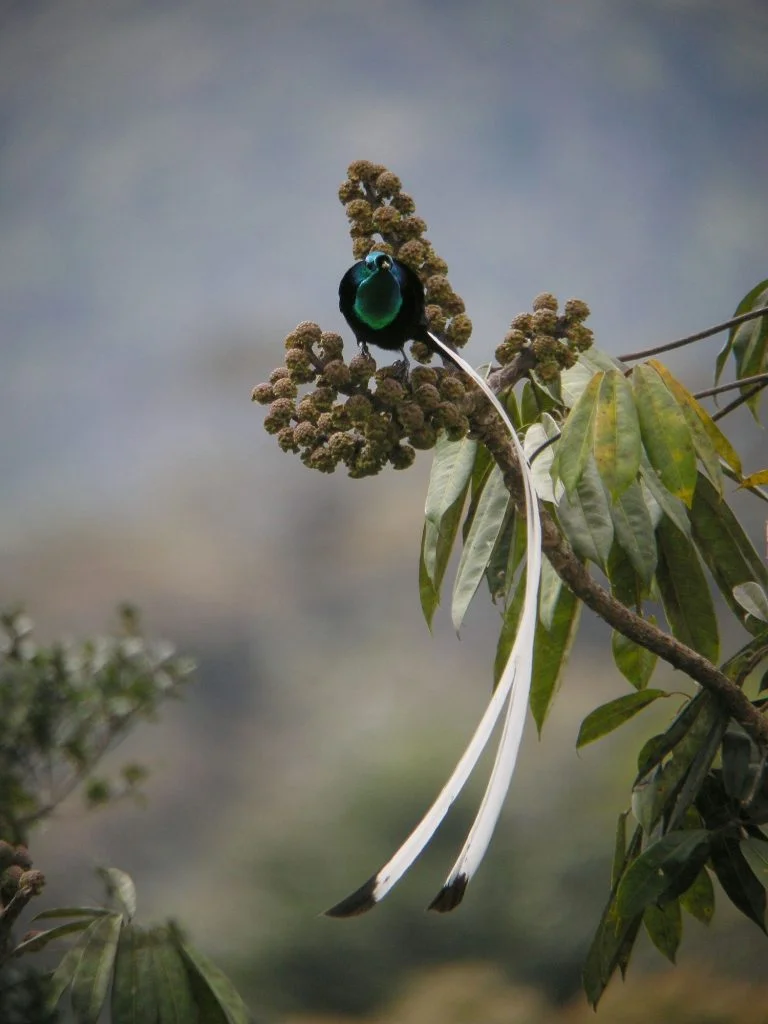
- Scientific Name: Astrapia mayeri
- Tail Length: 32cm
- Where Found: Papua New Guinea
The Ribbon-tailed Astrapia is a bird with a very long tail, considered one of the longest bird tails in the world. It measures up to 1 foot long, way longer than its body.
The tail is an outstanding physical feature. This bird is often found in New Papua Guinea, in the subalpine forests.
The Ribbon-tailed Astrapia uses its tail feathers for balance and communication.
This bird is classified as a bird of paradise, and it was recently discovered. Like other birds of paradise, the male Ribbon-tailed Astrapia is polygamous.
21. Leopard Whipray
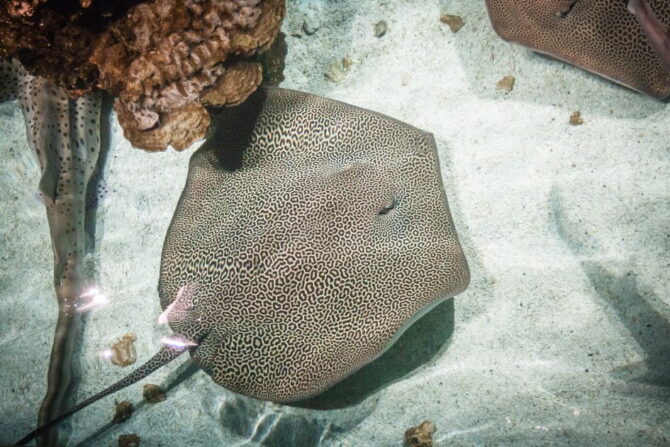
- Scientific Name: Himantura leoparda
- Tail Length: 410cm (Up to three times its body length)
- Where Found: Pacific Oceans
The Leopard whipray is an underwater creature with patterns resembling a leopard’s spots.
It is a stingray that isn’t well known by many people, including a good number of animal lovers. The Leopard whipray can be found in India, Sri Lanka, Japan, Taiwan, etc.
The tail helps the species navigate, and it uses the tail to propel itself forward while swimming.
22. Long-eared Jerboa

- Scientific Name: Euchoreutes naso
- Tail Length: 5.9 — 6.4 inches
- Where Found: China, Mongolia
The Jerboa lives in the deserted areas of Northwest China and southern Mongolia. Its tail measures up to 6.4 inches and is twice as long as the body.
Another distinctive characteristic of the Jerboa is its large ears which it uses to pick up the sounds of insects. This rodent is an insectivore.
The Jerboa’s tail is good for balance when the rodent wants to jump.
23. Long-tailed Giant Rat
- Scientific Name: Leopoldamys sabanus
- Tail Length: 9 inches
- Where Found: Asia
As the name shows, this rodent is big and has a long tail, which it uses for balance as it moves.
The Long-Tailed Giant Rat lives in Bangladesh, Cambodia, Laos, Indonesia, Malaysia, Vietnam, and Thailand.
Though it is of least concern, not much is known about this species.
24. Long-Tailed Grass Lizard
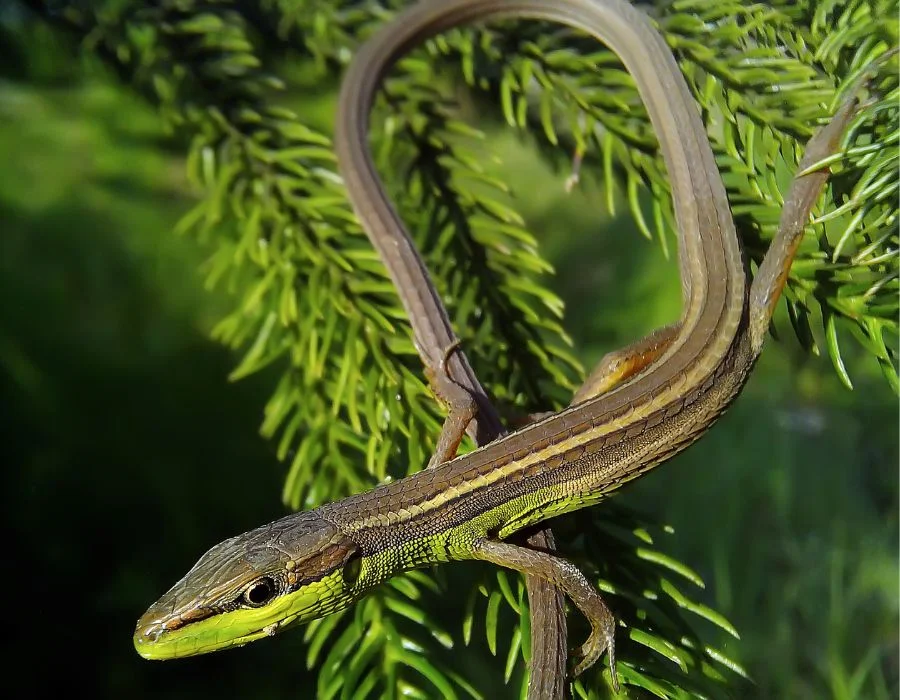
- Scientific Name: Takydromus sexlineatus
- Tail Length: 10 to 12 inches
- Where Found: Southeast Asia
The Long-Tailed Grass Lizard is so named because its long tail makes the reptile look like a snake with limbs.
With a tail length of 9 inches, the Long Tailed Grass Lizard earned its name. It lives in Southeast Asia.
The tail helps this Grass Lizard to maintain balance while it walks. It is also known as the Asian Grass Lizard and the Six-striped long-tailed grass lizard.
25. Pangolin
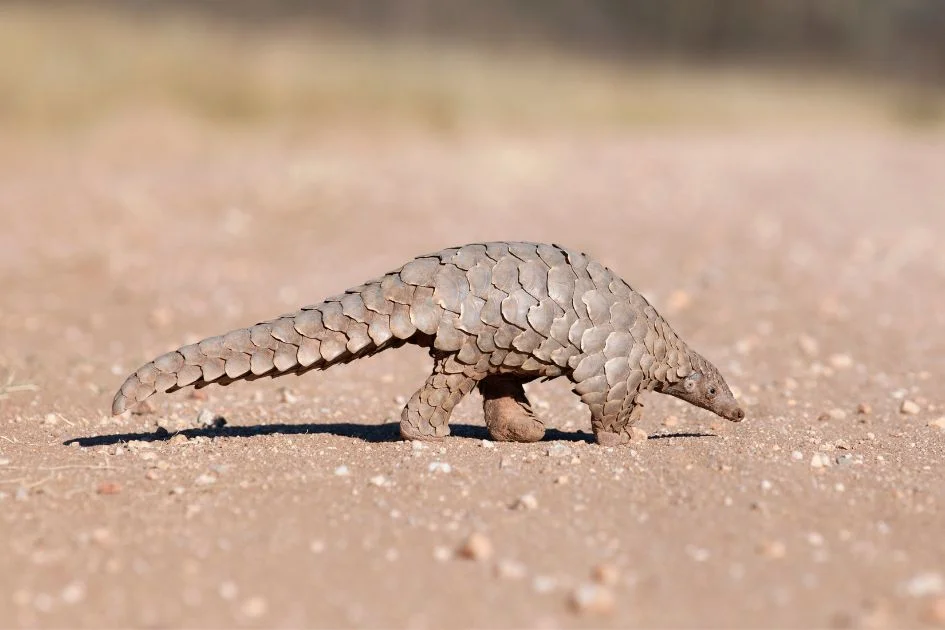
- Scientific Name: Pholidota
- Tail Length: 10 to 28 inches
- Where Found: Asia
The unique trait of the Pangolin that no other known mammal has is the keratin scales that serve as protection.
It also has a long tail that measures up to 28 inches and is a nocturnal, solitary animal.
The Pangolin’s tail helps maintain balance when it is running.
26. Giant Anteater
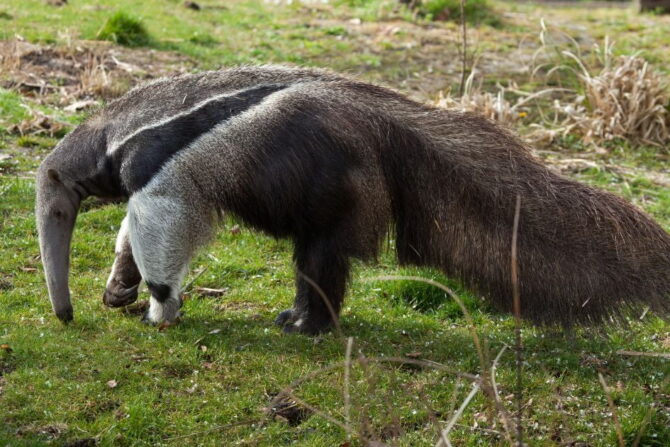
- Scientific Name: Myrmecophaga tridactyla
- Tail Length: 2.1 to 3 feet
- Where Found: Central and South America
The Giant Anteater is the biggest anteater species out of the four extant species.
It lives in Central and South America, inhabiting tropical forests and grasslands. This species is vulnerable, with many getting extinct.
Because of the short legs, Giant Anteaters won’t balance well without their long tail.
They also have long snouts and a long tongues which help them satisfy their insectivorous appetites.
27. South American Coati
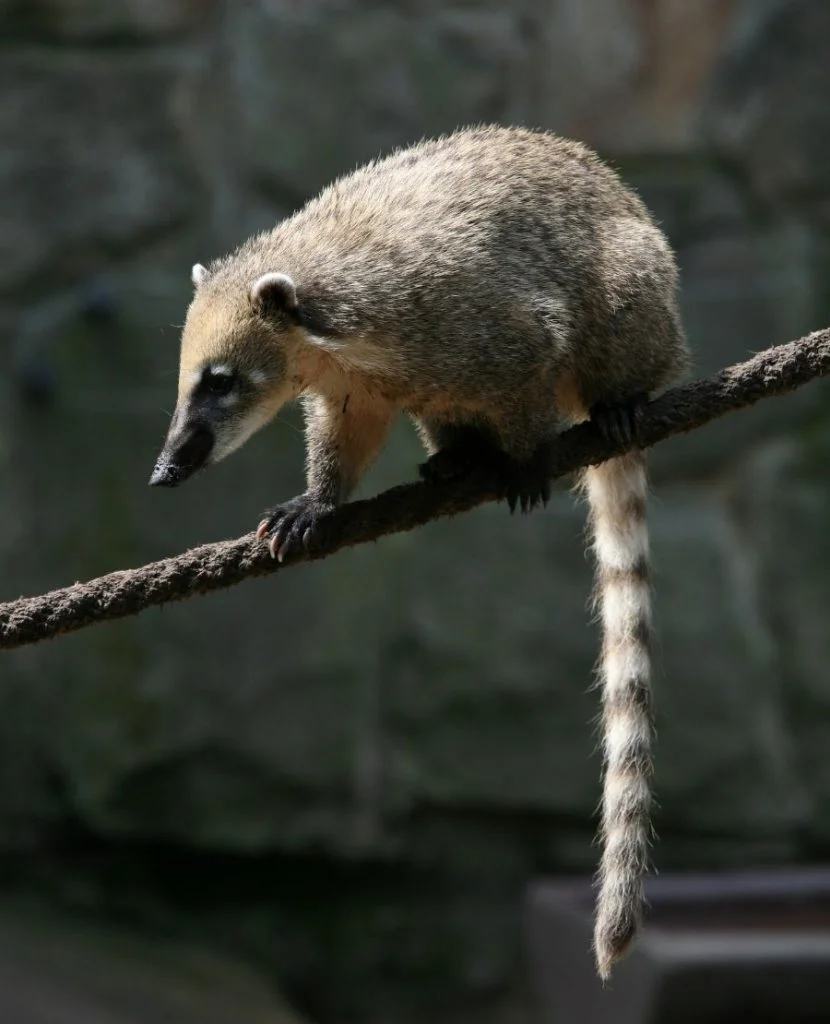
- Scientific Name: Nasua Nasua
- Tail Length: 56.5cm
- Where Found: South America
Also known as Ring-tailed Coati, the South American Coati lives in tropical and subtropical South America. Its habitat is the forest and forest areas.
You’ll know a Coati by its long snout, almost like a pig, and by its unusual tail. The tail measures up to 27 inches. This species is an omnivore and moves in a group called a troop.
The tails are used for balance and communication. It also helps keep a troop together when they enter new and uncharted territory.
28. Tree Kangaroo

- Scientific Name: Dendrolagus
- Tail Length: 17 to 36 inches
- Where Found: Papua New Guinea
Don’t imagine the standard Australian species that hops around with a pouch with the Tree Kangaroo.
The Tree Kangaroo, unlike the standard one, stays more on trees. It exists in Australia and other countries like Papua New Guinea and Indonesia.
The Tree Kangaroo’s tail helps it balance on trees. Unfortunately, the population is declining due to habitat loss.
29. Red Kangaroo

- Scientific Name: Macropus Rupus
- Tail Length: 1m
- Where Found: Australia
The Red Kangaroo is the standard one we know that hops on two legs and has a pouch. It also has a long tail, and it lives in Australia.
Its habitats include grasslands and deserts. The male and female Red Kangaroo has many differences.
The tail measures 3.3 feet which is half the body length. It helps the Kangaroo with balance and energy.
Related: Why Does Australia Have Weird Animals? (Strangest Species)
30. Snow Leopard

- Scientific Name: Panthera uncia
- Tail Length: 105cm
- Where Found: Asia
Last on our list of long-tailed animals is the Snow Leopard, a mammal found in places like China, Nepal, Bhutan, India, Pakistan, and Russia.
It is also known as the ounce and stays in the mountains. It is considered vulnerable because of its declining population.
The Snow Leopard’s tail measures up to 105cm, which it uses to keep balance while jumping from one rock to another.
Final Thoughts
Tails do a lot more for animals than we know, and it becomes a strong asset for animals with long tails.
Tails serve as protection, communication, balance, and navigation; even some boy animals use them to ask the ladies out.
The bottom line is that no animal part, including the tail, is less important.
You May Also Like the following articles:
- 30 Skinny Animals List (With Characteristics & Pictures)
- 25 Animals With Big Heads (List With Pictures)






